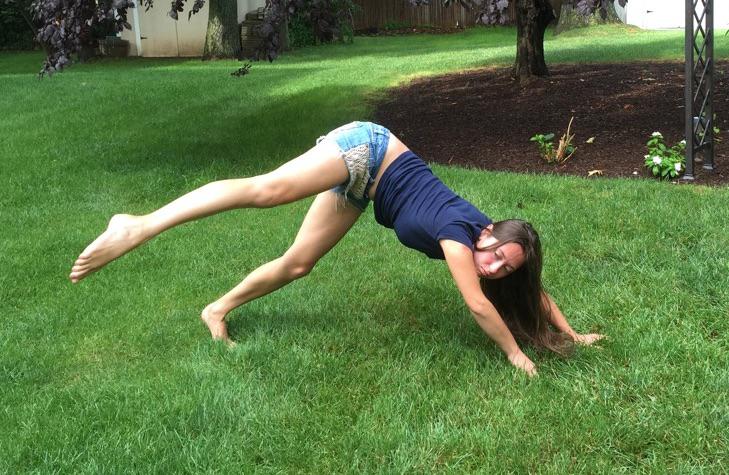The Actor’s Body
To celebrate the 25th anniversary of the Americans with Disabilities Act on July 26th, we're publishing a series of pieces focusing on issues of accessibility and visibility in theatre.
In this country, we frequently use a binary system to describe different types of bodies: a body is either “dis” abled or it is not. Perhaps a more accurate way to describe this would be to say that there are privileged bodies, and oppressed bodies. The line between “dis” abled and abled is often an arbitrary one. Although some bodies are privileged over others, no actor has an ideal body because each body is unique. They come in different shapes and sizes, with different strengths and limitations. Recognizing the diversity of the human body, its ability to adapt to situations and to preserve through struggle, will allow us to gain a greater appreciation for all the bodies that exist in our world.
According to legend, Jerzy Grotowski believed an actor needed to be able to walk backwards on her hands through a doorway. I’m confident that I’m not alone among my fellow actors when I say I would fail Grotowski’s test. Grotowski’s physical explorations were not meant to be a set of skills, but rather a tool for actors to explore their own bodies, to push themselves past what they thought was possible, and to build a stronger connection between the physical and spiritual instrument. It doesn’t matter that I will never be able to do a handstand (in the traditional sense) because I have Erb’s palsy in my right shoulder that limits my mobility in my right arm. It doesn’t matter if an individual cannot perfect one of Grotowski’s exercises because of physical “dis” ability. The forms are a pathway to truth, and can be edited, adapted, or tossed aside all together if they do not benefit the actor in their individual quest for understanding.
Although some bodies are privileged over others, no actor has an ideal body because each body is unique.
There is a current debate in this country about the ethics of able-bodied actors playing disabled roles. This conversation points to a larger problem: a limited view of what an actor’s body should be. We should instead be referring to the physical research of Grotowski; not the Grotowski who said that an actor must be able to walk backwards on his hands, but the Grotowski who, in Towards a Poor Theatre, said, “You begin where you are. It depends on individual temperament…It’s as if your animal body becomes master of the situation and starts to move…It’s nature and your body nature that is burning off.”
There is no correct actors’ body, just as there is no correct way for an actor to be trained. An actor does not need to perfect a movement or exercise, and if one focuses on perfection, they’ll miss the purpose of the work.
As a result of my Erb’s palsy, I have scoliosis in my back. I cannot do a “perfect” spinal undulation, in the sense that a movement originating in the lower portion of my spine travels up my body in a straight line. However, practicing spinal undulations has taught me about my body. I’ve known about the crookedness of my spine for years. A school nurse once gave me the exact measurements for my scoliosis. However, I never paid any attention to the shape of my spine, and in turn the shape of my body, until learning this basic exercise.

For those individuals who have limited mobility in their spine, adapting this exercise is a greater challenge. However, the movement itself is not important—what’s important is the connection the actor makes with their spine. In situations when the physical body cannot engage in the activity, or its engagement is limited, the imagination can serve as a tool for physical explorations. Isolating the spine from the remainder of the body and feeling the energy pulsate upwards through the spine can supply valuable information to the actor in place of the physical undulation. Of course, if this exercise fails to supply information that benefits the actor during her explorations, or if it cannot be adapted to the actor’s needs, then the actor should feel free to abandon it.
The Plastiques River exercise does not have a set structure, and because of this, it is easier for the actor to adapt to their individual needs. It begins when the actor feels an impulse somewhere in their body. For example, the part of the body where the impulse is felt should be specific: the right ankle, the left elbow, etc. When the actor first begins to learn Plastiques, he might find it necessary to perform the exercise in a more mechanical way, choosing an area to concentrate on until he starts to feel an impulse.
Part of Grotowski’s work is to challenge our routine interactions with our bodies and our environments in order to awaken a new level of understanding. Once while I was doing Plastiques, I felt an impulse in my right shoulder. When I felt this impulse, I took the opportunity to explore a part of my body that I often ignore. I felt myself moving my arm in ways that were completely new and foreign to me. This is not to say that I magically overcame the limits of my mobility. Rather, my shoulder and I gained a new level of intimacy, as I was able to explore the many ways it can move. If there was a risk that I might injure myself by following the impulse in my right shoulder, I could have chosen to ignore that impulse.
The flexibility of Grotowski’s physical explorations demonstrates that the actor’s body, or rather its ideal form, is a lie. It is an imaginary by-product of a culture that tries to value certain bodies over others. Anyone has the potential to become an actor if they are able to put in the work necessary to gain a greater command of their physical and spiritual instruments.



Comments
The article is just the start of the conversation—we want to know what you think about this subject, too! HowlRound is a space for knowledge-sharing, and we welcome spirited, thoughtful, and on-topic dialogue. Find our full comments policy here
Thanks for your piece, Natalie. I agree with you that there is no correct actors' body. But I disagree with you that the path towards greater acceptance of all human bodies, both privileged and oppressed, requires the collapse of the abled/disabled binary. I worry that by saying, "All bodies face oppression," we risk erasing or minimizing the narratives of individuals whose bodies have been regularly and systematically oppressed by laws and social institutions. I certainly don't love binaries, and I think you are advocating for a spectrum rather than a binary, which I think would allow for a more nuanced discussion of access and privilege. But I also think that binary thinking is useful in cases where certain members of the population systematically enjoy less access and privilege than others; I think it's important to be cognizant of those patterns of oppression. In the case of gender justice in theater, collapsing the binary in the way you have suggested might mean that we say cisgender men have been oppressed in certain ways, so they shouldn't be excluded from certain roles. Or in racial justice in theater, collapsing the binary might mean letting white people, or even mixed-race people, perform the stories of people of color. By preserving the binary framework, the idea isn't that we are excluding traditionally privileged populations from roles of the traditionally oppressed, or that we are preventing more nuanced understandings of privilege and oppression from surfacing. Rather, by preserving the binary framework, we hold ourselves accountable for recognizing marginalized groups' marginalization and creating spaces for them to tell their own stories. Though the line, as you point out, between privilege and oppression is sometimes blurry, it's also sometimes very clear who does and does not have access. I think it's important for those who do have access to make room for, and listen to, and bear witness to, those who don't.
Thank you for your comment Ashley! I agree that its important to recognize certain bodies have more access and are privileged over others. What I wanted to focus on in this piece is that disability is a social construction. Certainly, is one that has real impacts, mainly the oppression of certain types of bodies. However, I wanted to focus the readers attention on the way that certain bodies are labeled disabled not because of their abilities or weakness, but because of an image we as a society have about what a body should look like and how it should function. I don't consider myself disabled because I have limited mobility in my right shoulder,
but I do consider it disabling when I
and others in my situation are not cast because of the way our bodies are perceived. Your comment brings up an important point about recognizing who has historically been denied access and I'm glad you choose to write about it!